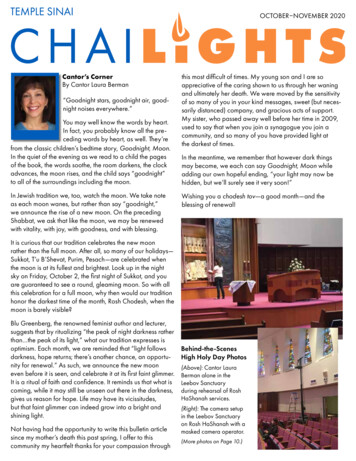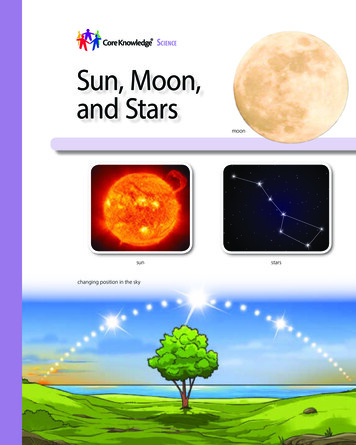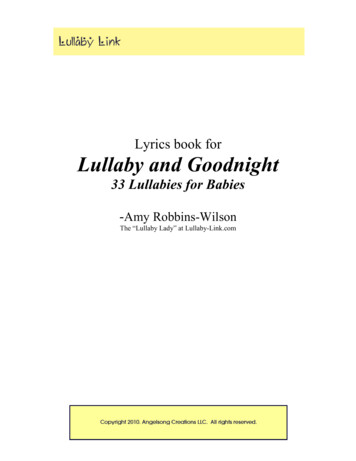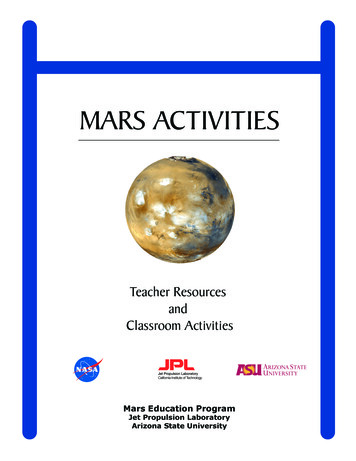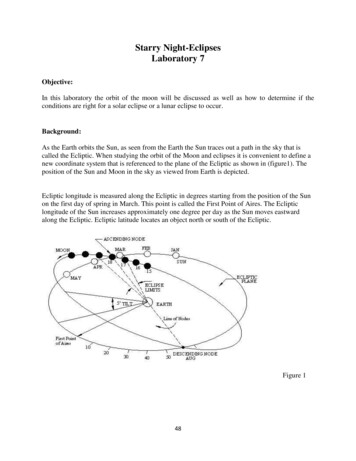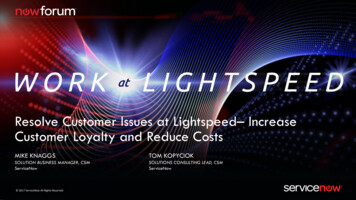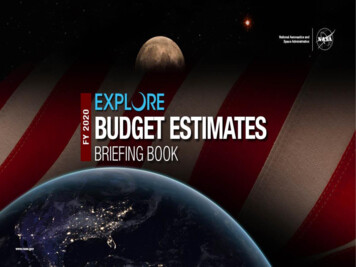
Transcription
Overall Principles and DirectionForward to the Moon, on to MarsPresident Trump’s Fiscal Year 2020 NASA budget is one ofthe strongest on record for our storied agency.In keeping with Space Policy Directive-1, it provides for thefoundation of a national exploration campaign that will usethe experience of the NASA workforce, coupled with theagility and innovation of our commercial and internationalpartners, to create an architecture that is open,sustainable and agile. This unified effort will inspiregenerations and change the course of history as werealize the next great scientific, economic and technicalachievements in space.1
Space Policy Directive OneNASA shall “lead an innovative and sustainable program ofexploration with commercial and international partners to enablehuman expansion across the solar system and to bring back to Earthnew knowledge and opportunities. Beginning with missions beyondlow-Earth orbit, the United States will lead the return of humans tothe Moon for long-term exploration and utilization, followed byhuman missions to Mars and other destinations.”2
3
2020 Budget Highlights Provides 21B, including 10.7B to continue building the key components ofthe Exploration campaign that will send astronauts to the Moon and beyond,including: The Space Launch System rocket, a heavy-lift expendable launch vehicle, toensure the rocket is operational in the early 2020s when it will be needed tocarry astronauts on board the Orion crew capsule to the vicinity of the Moon. The Lunar Gateway, an outpost orbiting the Moon in the mid-2020s. Commercial launch capabilities to enable regular, low-cost access to the lunarvicinity and surface. Lunar landers toenable cargo deliveryand human access tothe lunar surface bythe late 2020s. Building commercialand internationalpartnerships4
2020 Budget Highlights Develops the first elements of LunarGateway, the Power and PropulsionElement, ready for launch in 2022, and theUtilization module and ESPRIT enablingcrew to stay aboard starting in 2024. Develops and grows emerging technology andcommercial capabilities to deliver science andtechnology payloads to the Moon in preparationfor exploration and further enhance humanlunar lander capabilities. Focuses the SLS program on the completion ofthe initial version of SLS and supporting areliable annual SLS / Orion flight cadence.Defers funding of Block 1B for the SLS.5
Highlights (continued) The Lunar Surface Innovation Initiative (LSII)serves as a catalyst for enabling criticaltechnologies required for humans to successfullyoperate on the lunar surface. These includesurface power and in situ resource utilization. Utilizes public-private partnerships to develop ahuman-class lunar lander system that will, alongwith other Exploration Campaign activities, reestablish U.S. preeminence to, around, and onthe lunar surface leading to a human lunarlanding by 2028. Develops lunar robotic rover capabilities tosupport science and resource utilizationinvestigations, and technology. Drives toward a vibrant, U.S-led economy inEarth orbit funding the International SpaceStation as well as new commercial spacecapabilities that will facilitate a transition to amore robust and cost-effective approach tohuman space activities near the Earth.6
Highlights (continued) Continues robotic exploration of the SolarSystem including funding for the next Mars roverlaunch in 2020 and a Europa Clipper mission tolaunch in 2023. Initiates a Mars Sample Return Mission toretrieve samples from Mars, and return thosesamples with the first launch from anotherplanet. Continues exploring the universe with launch ofJames Webb Space Telescope in 2021.Provides no funding for WFIRST spacetelescope while Webb is still being built. Enables our wide-ranging science work onmany fronts, which continues to lead the worldin its size, scope, and scientific output. Consistent with prior budgets, provides nofunding for PACE, CLARREO-PF, and the Officeof Science, Technology, Engineering, andMathematics (STEM) Engagement.7
Highlights (continued) Supports transformative aeronautics technologyresearch to boost U.S. technological andeconomic leadership and support high qualityAmerican jobs including continued developmentof the X-59 QueSST flight demonstrator to helpusher in a new era of U.S. led supersonictransportation. Maintains robust investment in air trafficmanagement improvements that will safelyincrease air traffic capacity, reduce flight delays,and enable safe, robust UAS integration. Replenishes resources for mission enablingservices and operations, including criticalinvestments in maintaining test facilities,advancing cybersecurity protections, andensuring safe and reliable operations for NASA'sobjectives in space, science, aeronautics, andtechnology.8
Anticipated Accomplishmentsin FY 2020Exploration Research & DevelopmentGateway will continue building upon thecurrent commercial engagement contracts toadvance commercial habitation; AES willcontinue avionics, flight software, life support,in-space refueling capabilities, and othercommercial space industries while conductingflight experiments such as Saffire-IV.Deep Space ExplorationSystemsContinues delivery ofhardware for integrationand testing for theupcoming EM-1 and EM-2launchesCommercial CrewBoeing and SpaceX are on course forcertification of their transportation systems andto begin regularly flying operational missions tomeet ISS crew rotation obligations.James Webb SpaceTelescopeContinues testing andintegration of OTIS tospacecraft; on schedulefor March 2021 launchOther ScienceUse of emerging commercial lunarlander capabilities to deliver payloadsto surface of the Moon. Selects nextNew Frontiers mission, HeliophysicsSmall Explorer, Astrophysics MediumExplorer and suite of Earth VentureSuborbital-3 investigations.Exploration TechnologyLaunch and demonstrate 7 criticaltechnologies: laser comm, MOXIE, MEDA,MEDLI2, TRN, Astrobee and Lunarflashlight. Complete SEP CDR and start LSIIUrban Air MobilityAccelerates researchsupporting Urban AirMobility (UAM)9
FY 2020 Budget Request ( M)Budget Authority ( in Millions)Deep Space Exploration SystemsExploration Systems DevelopmentExploration Research & DevelopmentExploration TechnologyLEO and Spaceflight OperationsInternational Space StationSpace TransportationSpace and Flight Support (SFS)Commercial LEO DevelopmentScienceEarth SciencePlanetary ScienceAstrophysicsHeliophysicsJames Webb Space Telescope (JWST)AeronauticsSTEM EngagementSafety, Security, and Mission ServicesCenter Management and OperationsAgency Management and OperationsConstruction & Envrmtl Compl RestorationConstruction of FacilitiesEnvironmental Compliance and RestorationInspector GeneralNASA TotalFiscal Year2020202120182019202220232024 4,790.0 5,050.8 5,021.7 5,295.5 5,481.4 6,639.0 7,042.3 4,395.0 4,092.8 3,441.7 3,441.0 3,468.4 3,788.5 3,654.7 395.0 958.0 1,580.0 1,854.5 2,013.0 2,850.4 3,387.6 760.0 926.9 1,014.3 976.1 995.4 964.4 943.1 4,749.2 4,639.1 4,285.7 4,369.5 4,369.5 4,235.5 4,182.3 1,493.0 1,458.2 1,448.5 1,449.4 1,352.6 1,315.7 2,345.8 1,828.6 1,854.1 1,814.5 1,746.2 1,727.2 910.3 848.9 891.9 905.7 911.8 914.5 0.0 40.0 150.0 175.0 200.0 225.0 225.0 6,211.5 6,905.7 6,303.7 6,319.0 6,319.0 5,846.5 5,815.0 1,921.0 1,931.0 1,779.8 1,785.6 1,779.7 1,666.5 1,674.6 2,217.9 2,758.5 2,622.1 2,577.3 2,629.4 2,402.4 2,350.9 850.4 1,191.6 844.8 902.4 965.2 913.5 907.7 688.5 720.0 704.5 638.6 769.3 692.0 709.8 533.7 304.6 352.6 415.1 175.4 172.0 172.0 690.0 725.0 666.9 673.6 680.3 587.1 587.0 100.0 110.0 0.0 0.0 0.0 0.0 0.0 2,826.9 2,755.0 3,084.6 3,084.6 3,084.6 2,871.6 2,871.6 2,065.0 2,058.4 2,052.9 1,906.0 1,905.8 1,019.6 1,026.2 1,031.7 965.6 965.8 600.4 468.8 468.8 468.8 387.8 517.5 385.9 385.9 385.9 304.9 1,983.4 843.5 569.5 348.2 483.1 86.4 82.9 82.9 82.9 82.9 82.9 39.0 39.3 41.7 42.1 42.5 43.0 43.4 20,736.1 21,500.0 21,019.0 21,229.2 21,441.5 21,655.9 21,872.5FY 2018 reflects funding amounts specified in Public Law 115-41, Consolidated Appropriations Act, 2018, as adjusted by NASA’s FY 2018 Operating Plan.Table does not reflect emergency supplemental funds also appropriated in FY 2018, totaling 81.3 million.FY 2019 reflects funding as enacted under Public Law 116-06.10
Exploration Campaign FundingExploration Campaign 14,000.0 12,637.9 12,000.0 13,068.0 11,542.3 10,712.3 11,147.1 10,000.0 8,000.0 6,000.0 4,000.0 2,000.0 0.0202020212022Space Operations CoFExploration CoFElements of Science *Exploration TechnologyExploration Systems DevelopmentExploration Research & Development* Includes Lunar Discovery and Exploration Program and Mars Sample Return20232024LEO & Space Operations11
NASA Mission Launches(Fiscal Years 2019 – 2024)NASA Mission on US ELVExploration Systems Development MissionReimbursable Mission for NOAA**** NASA does not directly manage/controlJoint NASA-Int'l Partner MissionCommercial Crew MissionInt'l Mission with NASA contributionFuture Commercial Resupply MissionJoint NASA-USAF MissionAeronautics MissionNew lunar missions in orange textCommercial Resupply Services MissionJoint NASA-Public/Private Partnership Mission successfully launchedX Mission unsuccessful** Ground-based elements (includes suborbital) block of 5 missions*** Instrument only Future CRS Capabilities unknown, will be updated after award ofCRS-2 when cargo delivery capabilities are knownLBFDJPSS-2JUICE***DARTPsycheLucy Metop-C***Helio Expl MoO-5***JPSS-3 ContingencyLWS-MoO-4***Lunar Exploration MoO-3Helio Expl MoO-1***Europa Clipper(EELV)Lunar Exploration MoO-1GOES-TOMPS-L***Helio SMEX-2 BepiColombo***Mars-2020NISARHelio SMEX-1SET***ExoMars Rover***Sentinel-6aEVS-3**ICONSolar Orb***SWOTMAIA MoO*** GEDI MoO***SNC-1 CRS2GUSTO***EMIT MoO***OCO-3SpaceX-21 CRS2Landsat-9PREFIRE MoO***Disc-15SpaceX-18 CRSSpaceX-20 CRSXRISM***TSIS-2 MoO***MEGANE***SpaceX-17 CRSSpaceX-19 CRSEuclid***GeoCarbIMAP SpaceX-16 CRSNG-13 CRS2Future Cargo SPHERExAstro MoO-2***JPSS-3 FullNG-11 CRSNG-12 CRS2Lunar Exploration MoO-2Future Cargo Future Cargo Future Cargo NG-10 CRSCCtCap - SpaceX PCM-2TEMPO MoO***Future Cargo Future Cargo Future Cargo CCtCap - SpaceX PCM-1CCtCap - Boeing PCM-2IXPEFuture Cargo Future Cargo Future Cargo CCtCap DM-2 - SpaceXflight test w/ crewCCtCap - Boeing PCM-1WebbFuture Cargo Future Cargo Future Cargo CCtCap - Boeing crewedflight testEM-1Future Cargo Future Comm CrewFuture Comm CrewFuture Comm CrewCCtCap DM-1 - SpaceXflight test w/o crewTDM LCRDSpaceX-23 CRS2Future Comm CrewFuture Comm CrewFuture Comm Crew CCtCap - Boeing orbitalflight testTDM TRN***SpaceX-22 CRS2EM-2 Crew (ICPS, LunarFlyby)Gateway PPE - CLVHuman-Class Lunar Lander(Descent Module Demo)Ascent Abort-2TDM MOXIE***NG-14 CRS2TDM LOFTIDTDM CFMGateway - ESPIRT and UMTDM GPIMTDM MEDA***Future Comm CrewTDM SEPTDM IRMAEM-3 Crew-(ICPS, LunarGateway Orbit)TDM DSACTDM MEDLI2***Future Comm CrewTDM DSOC***TDM Satellite ServicingTDM ISRUFY 2019NotionalDates reflect Agency BaselineFY 2020FY 2021FY 2022FY 2023FY 202411
Deep Space Exploration Systems:Exploration Systems DevelopmentOutyears are notional( M)20202021202220232024ESD 3,441.7 3,441.0 3,468.4 3,788.5 3,654.7 Fully funds SLS, Orion and EGS to prepare forExploration Mission (EM-1), (EM-2), and futuremissions at the earliest technically achievabledates. Provides for mating of Orion’s major components(Launch Abort System, Orion Crew Module, andService Module) and delivering to GroundOperations for final preparation and stacking atKSC. Continues final assembly of the components forEM-1 by integrating the Interim CryogenicPropulsion Stage (ICPS), Launch Vehicle StageAdapter (LVSA) and Boosters including the SolidRocket Motor Segments. Validates all EGS software and hardware. Enables humans back to the vicinity of the Moon in2023.13
Deep Space Exploration Systems:Exploration Research and DevelopmentOutyears are notional( M)ER&D20202021202220232024 1,580.0 1,854.5 2,013.0 2,850.4 3,387.6 Advanced Cislunar and Surface Capabilities leads theExploration Campaign with developing a reusablehuman lunar landing architecture utilizing innovativepublic-private partnerships. Also advances partnerships through first elements ofGateway; the Power and Propulsion Element, readyfor launch in 2022, and the Utilization module andESPRIT enabling crew to stay aboard starting in 2024. AES pioneers human spaceflight systemsdevelopment, including habitation capabilities andsystems, crew mobility systems, vehicle systems,autonomous systems, and robotic precursors for futurehuman missions beyond low Earth orbit. Human Research Program mitigates the highest risksto astronaut health and performance to ensure crewsremain healthy and productive during long-durationmissions beyond Earth orbit.14
Exploration TechnologyOutyears are notional( M)Exploration Technology20202021202220232024 1,014.3 976.1 995.4 964.4 943.1 Serves as a catalyst for new technology required to “lead thereturn of humans to the Moon for long-term exploration andutilization (Space Policy Directive-1).” Funds the Lunar Surface Innovation Initiative, consisting of newand ongoing lunar surface technology research and developmentactivities to enable and enhance lunar exploration, andcontinuing to support Mars “tall pole” technology needs. Technology research and development spanning the TechnologyReadiness Level (TRL) spectrum; advancing early-stageconcepts, maturing key technologies and systems that enabledemonstrations in relevant environments. Readies Laser Communications Relay Demonstration for 2020 launch to enable opticalcommunications for both near-Earth and deep space missions; and three small spacecraft for flight. Develops Solar Electric Propulsion for Lunar Gateway, and continues public-private partnerships toflight demonstrate robotic in-space manufacturing and assembly technologies to build largestructures in a space environment. Encourages innovation and commercial participation, bringing together stakeholders from academia,industry, small businesses, and NASA workforce.15
LEO and Spaceflight Operations:International Space StationOutyears are notional( M)20202021202220232024ISS 1,458.2 1,448.5 1,449.4 1,352.6 1,315.7 Provides funding for the International SpaceStation which will be used to facilitate a transition toa more robust and cost-effective commercialapproach to human space activities near the Earth. Continues ISS Focus Areas:– Enable long-duration human deep space explorationvia research and technology demonstrations.– Enable development and advancement of acommercial marketplace in low Earth orbit.– Return benefits to humanity on Earth through spacebased research and technology development.– Maintain U.S. global leadership of space exploration. Through use of the National Laboratory, supportsabove focus areas, expands the number ofresearchers and companies using ISS, andenables new public-private partnerships.16
LEO and Spaceflight Operations:Space Transportation( M)SpaceTransportationOutyears are notional20202021202220232024 1,828.6 1,854.1 1,814.5 1,746.2 1,727.2 Continues NASA’s partnership with the U.S.commercial space industry to sendastronauts into space safely, reliably, andaffordably from American soil. Assures U.S. crew and cargo transportationto the ISS, bolsters American leadership,and reduces our dependence on Russianspaceflight capabilities for crewtransportation. Enables continued research and technology development on ISS by providingstable crew and cargo flight plan. Stimulates growth of the space transportation industry available to all potentialcustomers, strengthening America’s space industrial base.17
LEO and Spaceflight Operations:Space and Flight SupportOutyears are notional( M)20202021202220232024SFS 848.9 891.9 905.7 911.8 914.5 Continues mission critical space communications andnavigation services to customer missions, including human,science, and commercial crew and cargo missions. Initiates the Communications Services Program to beginpurchasing commercially provided satellite-based datarelaying services to more efficiently meet future needs Supports readiness and crew health for all NASA humanspace flight endeavors. Provides safe, reliable, and cost-effective launch servicesfor NASA payloads and launch vehicle acquisition andadvisory services to over 50 NASA scientific spacecraftmissions in various phases of development. Continues certification of new commercial launch vehicles. Provides NASA’s rocket testing capability to meet US rockettesting requirements and provides valuable propulsion datafor EM-1 and EM-2.18
LEO and Spaceflight Operations:Commercial LEO Development( M)20202021202220232024CLD 150.0 175.0 200.0 225.0 225.0 Assists commercial space industryto develop a sustained commerciallow earth orbit presence. Continues transition of low Earthorbit human space flightoperations to commercial partners. Encourages commercialdevelopment of platforms andcapabilities for use by the privatesector and NASA to enable aseamless transition from ISS. Increases efforts to develop acommercial space economy inLEO.19
Science: Earth ScienceOutyears are notional( M)Earth Science20202021202220232024 1,779.8 1,785.6 1,779.7 1,666.5 1,674.6 Initiates the Decadal Incubation project to address needsfor two targeted observable areas: Planetary BoundaryLayer and Surface Topography and Vegetation. Begins new Earth Venture Continuity element to focus onspecific instruments for continuity of measurements per2017 Decadal Survey recommendations. Proposes to terminate PACE and CLARREO Pathfinderbut restores funding for OCO-3 and DSCOVR. Supports formulation and development of Landsat-9,NISAR, SWOT, TEMPO, Sentinel-6, and TSIS-2. Supports over 30 missions in all stages of developmentand operation in addition to Airborne Science. Invests in CubeSats/SmallSats that can achieve entirelynew science at lower cost.20
Science: Planetary ScienceOutyears are notional( M)Planetary Science20202021202220232024 2,622.1 2,577.3 2,629.4 2,402.4 2,350.9 Continues Lunar Discovery and Exploration program in partnership with industry todevelop instruments and other payloads for missions to the lunar surface. Program will address exploration, science, and technology demonstration objectives asNASA prepares for a sustained program of lunar exploration. Continues development of Mars 2020 and Europa Clipper; for planned launches oncommercial launch vehicles in 2020 and 2023 respectively. Initiates a Mars Sample Return mission, incorporating commercial and internationalpartnerships. Continues the Planetary Defense program, includingDouble Asteroid Redirection Test (DART) and NearEarth Object Observations. Continues development of Lucy and Psychemissions. Supports ongoing New Frontiers missions, as well asfor a new selection in FY 2019. Invests in CubeSats/SmallSats that help achieveentirely new science at lower cost.Dawn Image of Ceres on January 13, 2015 Supports operations on 13 Planetary missions.21
Science: AstrophysicsOutyears are notional( M)Astrophysics20202021202220232024 844.8 902.4 965.2 913.5 907.7 Formulates or develops, IXPE, GUSTO,XRISM, Euclid, and SPHEREx a newMIDEX mission selected in February. Operates 10 missions, and the balloonprogram. Supports the TESS exoplanetmission launched on April 18, 2018. Continues operations of the HubbleSpace Telescope; now in its 28thyear Consistent with the FY 2019 request this budget proposes termination of the WFIRST missionin FY 2020 due to its significant cost and higher priorities within NASA, including the need tocomplete the James Webb Space Telescope. Continues support of CubeSats/SmallSats, taking advantage of the technological progress inthe public and private sector toward meeting high-priority science goals.22
Science: James Webb Space TelescopeOutyears are notional( M)Webb20202021202220232024 352.6 415.1 175.4 172.0 172.0 Budget shifts Webb funding fromAstrophysics to its own themeline as shown in table above. Supports the new launch date ofMarch 2021. Applying Independent ReviewBoard and Standing ReviewBoard recommendations. Completes Integration of OTIS tothe spacecraft element. Conduct testing of the Webbflight operations system andscience processing system. Transport Webb to the launchsite in Kourou, French Guiana.23
Science: HeliophysicsOutyears are notional( M)Heliophysics20202021202220232024 704.5 638.6 769.3 692.0 709.8 Formulates the InterstellarMapping and Acceleration Probe(IMAP) -- which will helpresearchers better understandthe heliosphere, a magneticbubble surrounding andprotecting our solar system. NASA plans to provide a ride toNOAA’s Space Weather FollowOn with the IMAP launch. Develops Solar Orbiter Collaboration (SOC) partnership with the European SpaceAgency (ESA), readying for launch in 2020 and Ionospheric Connection Explorer(ICON), readying for launch in 2019 Continues support for CubeSats/SmallSats, Sounding Rockets, and SpaceWeather Science Applications. Supports operation of 16 additional missions including Parker Solar Probe, whichlaunched last year.24
Aeronautics( M)Aeronautics20202021202220232024 666.9 673.6 680.3 587.1 587.0 Completes final assembly of the X-59 aircraft for theLow Boom Flight Demonstration mission and lays thegroundwork for delivery of scientifically acquired dataof community response to low sonic boom toregulatory organizations (e.g., ICAO, FAA) to usher ina new era of supersonic flight for flying public. Advances technology for the next generation ofsubsonic transport including electric aircraft propulsionwith a focus on maturing and demonstrating a practical1MW electric propulsion system in flight. Accelerates research in urban air mobility to support industry readiness to perform advancedsafety and operations testing for emerging global urban and inter-urban air mobility markets. Completes a series of air traffic management demonstrations with the FAA, airlines, andairports that validate new capabilities that improve airport operating efficiency. Also, completesdemonstrations of technologies to integrate larger UAS into the NAS as well as managesmaller UAS at lower altitudes. Transfers Aeroscience Evaluation and Test Capabilities Project from Aeronautics to SSMS.25
STEM Engagement Proposes termination of funding for NASA’s Office of STEM Engagement,including its portfolio of grants and cooperative agreements and redirects fundsto NASA’s core mission of exploration. NASA headquarters will continue to be accountable for strategic directionand coordination of the agency’s STEM engagement efforts. Continues internships, fellowships, and student STEM engagement activitiesand learning opportunities funded by NASA mission directorates. SMD’s Science Activation program will continue to focus on delivering SMDcontent to learners of all ages through cooperative agreement awards.26
Safety, Security, and Mission ServicesOutyears are notional( M)SSMS20202021 3,084.6 3,084.6202220232024 3,084.6 2,871.6 2,871.6 Funds ongoing operations across NASACenters and major component facilities toaccomplish national space policy priorities ofscientific discovery, exploring and expandingthe boundaries of human presence in space,and developing the technologies of tomorrow. Provides independent technical and safetyoversight of NASA missions and operations. Increases facilities maintenance to reducedeferred maintenance backlog and systemdegradation in mission critical test facilities. Provides core services to support mission roles and responsibilities by optimizingacquisition, human capital management, budget management, and facilitiesmanagement to maintain the required set of capabilities. Provides strategic information technology (IT) investments to improve security, reducecosts, and increase efficiency by modernizing systems, increasing automation, anddelivering affordable enterprise-wide solution. Strengthens cybersecurity capabilities by safeguarding critical systems and data pluscontinues to support improved overall management of IT.27
Construction of Facilities and EnvironmentalCompliance and RestorationOutyears are notional( M)Construction & ECR20202021202220232024 600.4 468.8 468.8 468.8 387.8 Funds repair, revitalization, demolition, andrecapitalization projects that reduce theAgency’s footprint and provide efficient,modernized facilities. Invests in energy savings projects to reduceutility usage and costs. Constructs new or modified facilities to conductNASA’s program missions, including newresearch facilities at LaRC and JPL. Manages NASA’s environmental clean-up responsibilities. FY20 budget enables a stronger revitalization strategy to replace older and costlyfacilities, beyond their design life, with more modern and less costly capabilitiessupporting agency mission objectives28
Long-Term Exploration and Utilization of the Moon(current plan)With this Budget, by 2028 NASA will have: Provided opportunities for at least 13 deep spaceCubeSat missions, including 7 to the Moon (on EM-1) Completed 2 Exploration Mission test flightswith SLS and Orion Completed 5 additional EMs on SLS and Orion and14 commercial flights Flown up to 10 CLPS opportunities,enabling new science and demonstratingnew technologies supporting human returnto the lunar surface Delivered a rover to investigate volatiles Demonstrated, for the first time, a reusablelunar ascent vehicle Used, for the first time on the Moon, key explorationtechnologies including precision landing, cryogenicfluid management, in-situ resource utilization, andsurface nuclear power Returned humans to the lunar surface Demonstrated key technologies and operationsneeded toenable the first human missions to Mars
30
Acronyms AES: Advanced Exploration SystemsCLARREO: Climate Absolute Radiance and Refractivity ObservatoryCCP: Commercial Crew ProgramCLPS: Commercial Lunar Payload ServicesCSP: Communications Services ProgramDART: Double Asteroid Redirection TestDSCOVR: The Deep Space Climate ObservatoryECOSTRESS: Ecosystem Spaceborne Thermal Radiometer Experimenton Space StationEGS: Exploration Ground SystemsEM: Exploration MissionEEVM: Earth Venture MissionEVS: Earth Venture Sub-Orbital SolicitationFAA: Federal Aviation AdministrationGUSTO: Galactic/extragalactic ULDB Spectroscopic TerahertzObservatoryICON: Ionospheric Connection ExplorerICPS: Interim Cryogenic Propulsion StageISS: International Space StationIXPE: Imaging X-ray Polarimetry ExplorerJPSS: Joint Polar Satellite SystemLBFD: Low-Boom Flight DemonstrationLCRD: Laser Communications Relay DemonstrationLDEP: Lunar Discovery and Exploration ProgramLEO: Low Earth OrbitLSII: Lunar Surface Innovative InitiativeLVSA: Launch Vehicle Stage AdapterMEDA: Mars Environmental Dynamics AnalyzerMEDLI2: Mars Entry, Descent, and Landing Instrumentation 2MIDEX: Medium-Class ExplorersMOXIE: Mars Oxygen In-Situ Resource Utilization ExperimentMSR: Mars Sample ReturnNextSTEP: Next Space Technologies for Exploration PartnershipNISAR: NASA-ISRO Synthetic Aperture RadarOCO-3: The Orbiting Carbon Observatory 3 OSIRIS-Rex: Origins, Spectral Interpretation, Resource Identification,Security, Regolith ExplorerOTIS: Optimal Trajectories by Implicit SimulationPACE: Plankton, Aerosol, Cloud, ocean EcosystemPPE: Power Propulsion ElementPSP: Parker Solar ProbeQueSST: Quiet Supersonic Technology X-PlaneSBIR: Small Business Innovation ResearchSLS: Space Launch SystemSMD: Science Mission DirectorateSMEX: Small Explorer classSOC: Solar Orbiter CollaborationSTEM: Science, Technology, Engineering and MathematicsSTTR: Small business Technology TransferSWOT: Surface Water and Ocean TopographyTDM: Technology Demonstration MissionTEMPO: Tropospheric Emissions Monitoring of PollutionTESS: Transiting Exoplanet Survey SatelliteTRL: Technology Readiness LevelTRN: Terrain Relative NavigationTROPICS: Time-Resolved Observations of Precipitation structure andstorm Intensity with a Constellation of SmallsatsTSIS: Total and Spectral Solar Irradiance SensorUAM: Urban Air MobilityUAS: Unmanned Aircraft SystemsXRISM: X-ray Imaging and Spectroscopy MissionWebb: James Webb Space TelescopeWFIRST: Wide Field Infra Red Survey telescope (AFTA: AstrophysicsFocused Telescope Assets)31
Enables our wide-ranging science work on many fronts, which continues to lead the world in its size, scope, and scientific output. Consistent with prior budgets, provides no funding for PACE, CLARREO-PF,
